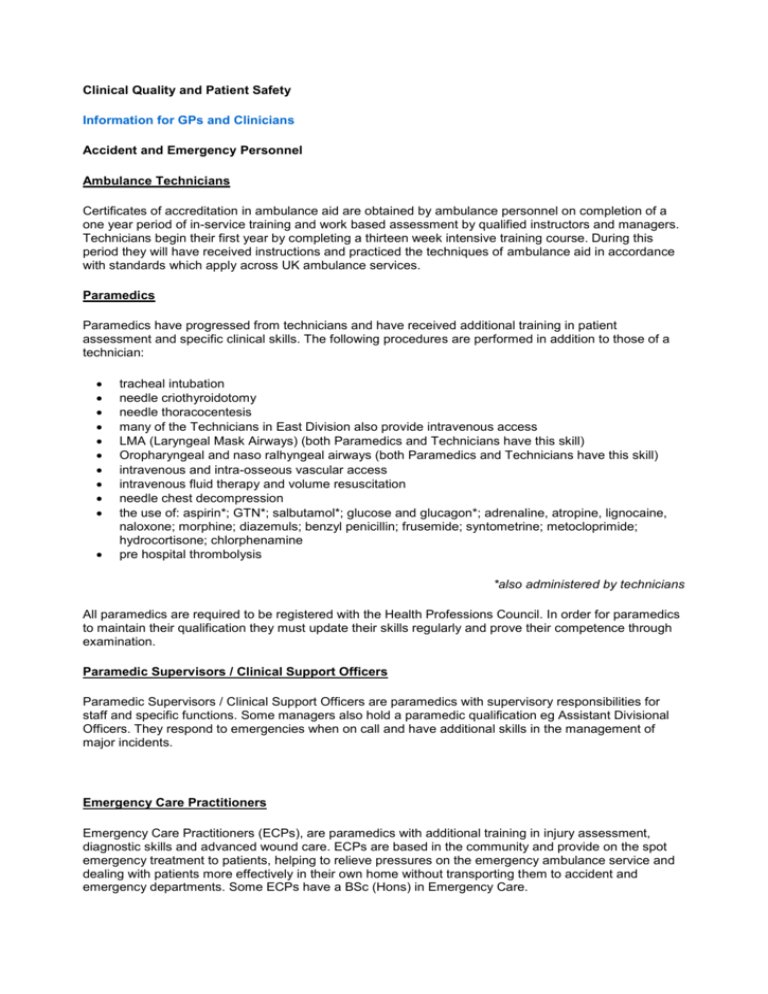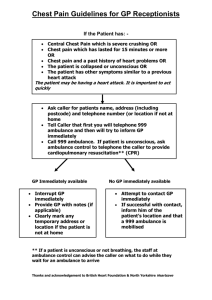Clinical Quality and Patient Safety
advertisement

Clinical Quality and Patient Safety Information for GPs and Clinicians Accident and Emergency Personnel Ambulance Technicians Certificates of accreditation in ambulance aid are obtained by ambulance personnel on completion of a one year period of in-service training and work based assessment by qualified instructors and managers. Technicians begin their first year by completing a thirteen week intensive training course. During this period they will have received instructions and practiced the techniques of ambulance aid in accordance with standards which apply across UK ambulance services. Paramedics Paramedics have progressed from technicians and have received additional training in patient assessment and specific clinical skills. The following procedures are performed in addition to those of a technician: tracheal intubation needle criothyroidotomy needle thoracocentesis many of the Technicians in East Division also provide intravenous access LMA (Laryngeal Mask Airways) (both Paramedics and Technicians have this skill) Oropharyngeal and naso ralhyngeal airways (both Paramedics and Technicians have this skill) intravenous and intra-osseous vascular access intravenous fluid therapy and volume resuscitation needle chest decompression the use of: aspirin*; GTN*; salbutamol*; glucose and glucagon*; adrenaline, atropine, lignocaine, naloxone; morphine; diazemuls; benzyl penicillin; frusemide; syntometrine; metocloprimide; hydrocortisone; chlorphenamine pre hospital thrombolysis *also administered by technicians All paramedics are required to be registered with the Health Professions Council. In order for paramedics to maintain their qualification they must update their skills regularly and prove their competence through examination. Paramedic Supervisors / Clinical Support Officers Paramedic Supervisors / Clinical Support Officers are paramedics with supervisory responsibilities for staff and specific functions. Some managers also hold a paramedic qualification eg Assistant Divisional Officers. They respond to emergencies when on call and have additional skills in the management of major incidents. Emergency Care Practitioners Emergency Care Practitioners (ECPs), are paramedics with additional training in injury assessment, diagnostic skills and advanced wound care. ECPs are based in the community and provide on the spot emergency treatment to patients, helping to relieve pressures on the emergency ambulance service and dealing with patients more effectively in their own home without transporting them to accident and emergency departments. Some ECPs have a BSc (Hons) in Emergency Care. When a 999 call comes into ambulance Control, the patient’s injuries are assessed and an ECP contacted if appropriate. They can treat minor injuries (wounds, burns, muscoskeletal injuries) and minor illnesses (falls, blackouts or blood loss) which would normally go by ambulance into accident and emergency departments. ECPs are also able to call upon other agencies such as social services, occupational therapy, physiotherapy or mental health organisations in order to provide the best possible care for the patient. They can also refer patients to community hospitals for assessment and treatment or for rehabilitation, eg after a patient has had a fall in the home. This allows the Trust to provide a patient centred model of care with community-based clinical assessment. Others Involved in Delivering Emergency Care and Urgent Transport Urgent Transfer Care Assistants (UTCAs) UTCAs are trained in basic life support and are able to use a defibrillator. They are trained to drive under emergency conditions. They may respond to an emergency when other resources are occupied. Responders The Trust uses first responders to respond to specific life-threatening emergencies (for example suspected cardiac cases) in advance of the ambulance’s arrival, providing the best opportunity of survival for patients, particularly in rural areas. First responders comprise of off duty Trust staff, fire and rescue co-responders, police, RNLI, beach rescue co-responders and community volunteers and are all trained in basic life support and carry equipment which allows them to manage airways, give oxygen therapy and use an automated external defibrillator. The scheme is operated using an automatic paging system. This means first responders are automatically paged by the accident and emergency Control on receipt of an emergency in their operating area. If they are available they contact Control, either by radio or by using a specific telephone number designated as an emergency line. The Trust is keen to involve healthcare professionals as ambulance responders. Please contact the Lead Community Engagement Manager on 01392 261500. Accident and Emergency Vehicles A number of ambulance resources may be utilised to attend an emergency call. These include: ambulances (with two personnel) rapid response cars (with one crew member) urgent transfer vehicles (used for long distance and inter hospital transfers and urgent calls with two crew members) paramedic motorcycles paramedic/technician bicycles the Cornwall, Devon or Dorset & Somerset air ambulances ambulance boat (Isles of Scilly only) South Western Ambulance Service emergency ambulances are equipped to a high specification standard inventory. Emergency ambulances all carry defibrillators and our staff are trained to use them in accordance with pre-determined protocols laid down by the Resuscitation Council. Equipment carried on all emergency ambulances and urgent transfer vehicles includes: 12 lead ECG with telemetry immediate aid response kit (containing: resuscitation bag/valve with adult and child masks, hand held suction, airways, burns gel packs, assorted dressings) portable oxygen therapy set with a range of face masks and portable ventilator battery operated suction unit pulse oximeter manual sphygmomanometer and stethoscope defibrillator with accessories drugs packs, intravenous fluids and cannulae entonox giving set rigid neck collars of various sizes long spinal board, orthopaedic stretcher vacuum splints and fracture splints moving and handling equipment, pillows, blankets and carrying chairs universal precaution equipment including disposable gloves, face masks, aprons, waste bins and sharp boxes maternity pack and blankets tissues and incontinence pads Routine Ambulance Journeys Patient Transport Service The Trust’s Patient Transport Service (PTS) conveys non-emergency, non-urgent patients who do not require an emergency or urgent response, but, due to their medical condition, are unable to use public transport and need planned assistance to attend NHS appointments. Bookings are matched to patient needs - all PTS ambulances have easy access for patients, in addition to walking patients, they have been designed to carry wheelchair and stretcher patients in safety and comfort. Ambulance Care Assistants PTS ambulance crews usually consist of two trained ambulance care assistants (ACAs). ACAs are trained in first aid and to assist and care for patients who may have special needs. They are trained in basic life support (including defibrillation) and first aid including oxygen therapy. Volunteers Unpaid volunteers work on the voluntary ambulance car service (VACS) and take patients, who require minimal assistance to walk and with a small amount of hand luggage, to treatment centres. Some voluntary ambulance cars can accommodate personal patient wheelchairs but these have to be folded and placed in the boot. Volunteer car drivers are not expected to carry out manual handling operations such as lifting patients or heavy luggage, and so if the patient is unable to manage stairs at their home they are unsuitable for a voluntary car. Changes to the co-ordination of VACS are differing stages across the operational area of South Western Ambulance Service NHS Trust. More details can be obtained from Operational Lead Manager, Graham Smart on 01392 261500. Escorts for Non-Urgent Patients Some patients may need to be provided with a medical or nurse escort by the hospital unit. South Western Ambulance Service will do its best to return clinical escorts to their base after completion of the ambulance journey, but for operational reasons this may not always be possible. Requests to PTS Control for non-medical escorts should only be for the following categories of patient: children under 16 patients with loss of senses (eg hearing, speech or sight) mentally confused patients patients undergoing traumatic treatment sessions Please advise PTS Control at the time of booking of the need for an escort, so that an ambulance seat can be allocated. Please remember that each escort will occupy a seat that might otherwise be used by a patient. Requesting Patient Transport Services Patients must have a medical need to receive NHS transport. Click here for the arrangements for booking PTS transport in each area. Bookings can normally only be accepted from authorised hospital sources (such as referral centres) or GPs. They should be made at least 48 hours before the patient’s journey is required. In the event of a cancellation please inform the relevant Control immediately to save a wasted journey which will be charged to the relevant contract holder. PTS generally operates between 1000 and 1500, Monday to Friday. Patients should ideally be given appointment times which allow their journey to be completed within these times. Local agreement with an individual trust may exist to accommodate attendance at specialist centres. Please inform patients using Voluntary Ambulance Car Services transport that a cost will be incurred unless exempt from the charges. When Making a Booking, Please: allow at least 48 hours notice (late notice bookings may sometimes be accommodated however the Trust can not guarantee this will be possible due to demand on services) include the patient’s full address (including postcode) and telephone number tell us the patient’s destination (eg hospital and clinic, ward. Outpatients is insufficient) state the category of transport (see below) advise if a child seat is required advise if the patient has any mobility aids which need to travel with them advise of any infectious diseases (eg MRSA) advise if the patient is potentially violent advise if escorts are authorised to travel with the patient (for medical need only: children under 16, patients with loss of senses, mentally confused patients, patients undergoing traumatic treatment or injury) advise of any additional special needs (eg oxygen therapy) So what does the jargon mean? Car One (C1) - the patient can travel sitting in a car and move with the assistance of one person, without a requirement to be ‘lifted’. Car Two (C2) - the patient can travel sitting but needs the assistance of two people to walk or may need to be helped into the ambulance or up stairs. Stretcher (Str) - the patient needs to travel lying down on a stretcher in the ambulance and needs to be carried up and down any stairs. A stretcher patient takes the same room as three C2 seats. Wheelchair (w/c) - the patient is required to travel in their own wheelchair due to medical reasons. Electric or other model wheelchairs are booked as three seats.








